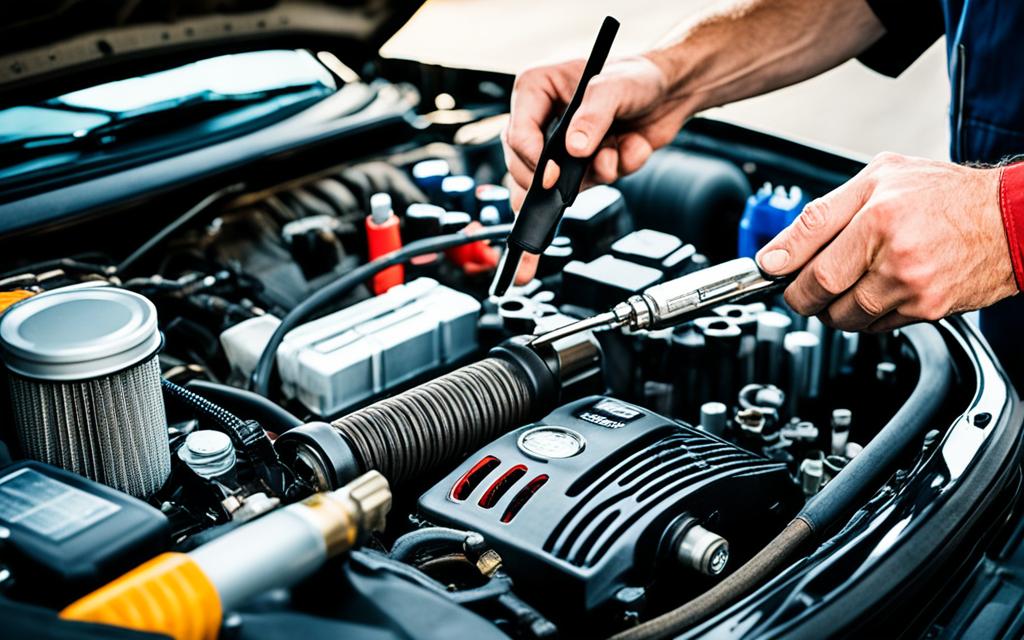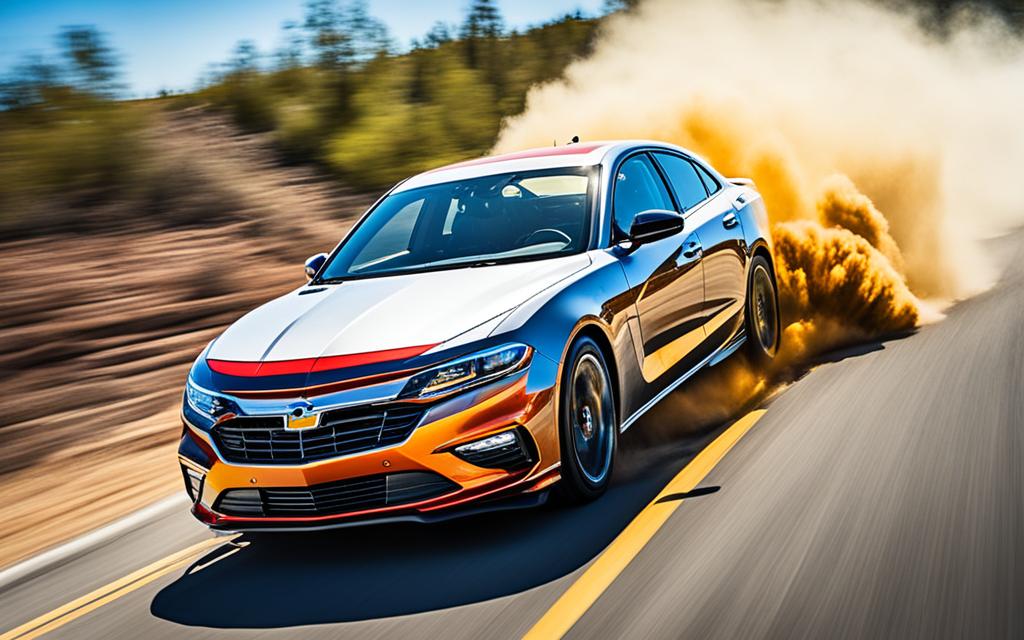Welcome to the world of revving a car, where the untapped potential of your engine awaits. When done correctly, revving can offer incredible benefits in terms of performance enhancement and a more thrilling driving experience. However, it’s crucial to approach revving with caution and follow the proper techniques to prevent any damage to your engine.
In this section, we will provide you with a comprehensive guide on how to rev a car’s engine safely and effectively. From understanding the basics of revving to exploring advanced techniques, we’ll equip you with the knowledge you need to unleash your car’s power without compromising its longevity.
Key Takeaways:
- Revving a car’s engine can enhance performance and provide a more exhilarating driving experience.
- It’s important to rev a car safely to prevent damage to the engine.
- Understanding the basics of revving and employing proper techniques is crucial for optimal results.
- Revving techniques can improve power delivery and throttle response.
- Before revving, consider factors such as engine temperature and fuel type to ensure safety and avoid unnecessary risks.
Understanding the Basics of Revving a Car
Revving a car is an essential skill for every car enthusiast, especially when it comes to manual transmission vehicles. Understanding the fundamentals of revving can significantly enhance your driving experience and unleash the true potential of your car’s engine. In this section, we will explore the key concepts behind revving a car and how to effectively control it in different driving scenarios.
One crucial aspect of revving a car is understanding the concept of revs per minute (RPM). RPM refers to the number of rotations the engine’s crankshaft makes in one minute. It is a measure of how fast the engine is revving. By increasing the RPM, you can increase the power and torque output of your car’s engine.
Controlling revving in a manual transmission vehicle involves mastering the art of managing the clutch, throttle, and gearbox harmoniously. When downshifting, rev matching plays a vital role in ensuring a smooth transition between gears. By matching the RPM to the appropriate gear, you can minimize any jolts or jerks, making your driving experience seamless and comfortable.
Mastering Rev Matching
Rev matching is an advanced technique that involves precisely matching the engine speed to the speed of the wheels when shifting gears. This technique allows for smoother gear changes without putting excess strain on the drivetrain. To master rev matching, follow these steps:
- Approach the shift point and prepare to downshift.
- Depress the clutch pedal fully to disengage the engine from the drivetrain.
- While still holding the clutch pedal, blip the throttle to increase the engine RPM.
- Engage the lower gear and smoothly release the clutch pedal while maintaining throttle input.
- Once the clutch is fully engaged, the engine speed should match the wheel speed, resulting in a seamless gear change.
Mastering rev matching takes practice and a good understanding of your car’s engine characteristics. But once you’ve perfected this technique, you’ll experience smoother gear changes, reduced wear and tear on the drivetrain, and improved performance.
| Revving Scenarios | Revving Technique |
|---|---|
| Launch Control | High RPM clutch engagement |
| Passing Other Vehicles | Quick downshift and high RPM acceleration |
| Track Racing | Optimized upshifting at redline for maximum power delivery |
| Hill Climbing | Rev matching during downshifting for smooth power transfer |
Remember, while revving can enhance your driving experience, it’s important to rev within the recommended limits of your car’s engine. Excessive revving can lead to engine damage and reduce the lifespan of vital components. Always ensure your engine is adequately warmed up before engaging in spirited driving.
In the next section, we will delve into the proper technique to rev a car’s engine, ensuring safety and optimal performance. Stay tuned!
The Proper Way to Rev a Car’s Engine
Revving a car’s engine can be an exhilarating experience, but it’s crucial to do it safely and without causing any damage. Mastering the proper technique will not only enhance your driving enjoyment but also ensure the longevity of your vehicle.
Here are some step-by-step instructions and tips to help you rev a car’s engine safely:
- Warm up the engine: Before revving, allow your car’s engine to reach its optimal operating temperature. This ensures proper lubrication and reduces the risk of engine damage.
- Use the appropriate gear: If you have a manual transmission, ensure that you’re in neutral or have the clutch fully engaged. For automatic transmissions, make sure the car is in park or neutral.
- Step on the gas pedal: Press the gas pedal gradually but firmly, increasing the engine’s RPM (revolutions per minute) gradually. Avoid sudden, jerky movements that can result in engine stress.
- Listen to the engine: Pay close attention to the sound of the engine as you rev it. It should sound smooth and steady, indicating proper functioning. Any unusual noises may indicate a problem that requires attention.
Remember, safety should always be a top priority when revving a car’s engine. Here are some additional tips to keep in mind:
- Choose a safe location: Find an open, spacious area away from pedestrians and other vehicles to ensure your safety and the safety of others.
- Watch your RPM: Avoid excessive revving that exceeds the recommended RPM range for your specific car model. Check the owner’s manual or consult with a professional if you’re unsure.
- Respect engine limits: Each car has its limits when it comes to revving. Pushing the engine beyond its capabilities can result in damage and costly repairs. Aim for a smooth and controlled revving experience.
By following these guidelines, you can rev a car’s engine safely and enjoy the thrill of enhanced performance without compromising the health of your vehicle.
Revving Techniques for Enhanced Performance
In this section, we will explore various revving techniques that can significantly improve your car’s performance. Whether you’re looking for optimized power delivery or enhanced throttle response, these expert tips will elevate your revving experience to the next level.
One effective technique for improving performance is to rev-match during gear changes. This technique involves precisely matching the engine’s RPM to the speed of the wheels, resulting in smoother and faster shifts. By revving the engine before shifting gears, you can seamlessly transition without any jarring effects.
Another technique to consider is power revving. This involves briefly increasing the RPM while the car is stationary or in neutral to create a surge of power when accelerating. Power revving helps to build boost pressure, delivering more torque and horsepower when you hit the throttle.
For those seeking improved throttle response, power revving can also be utilized in motion. By quickly releasing the throttle and then reapplying it, you can provoke a sharp response from the engine, enabling faster acceleration and better control.
Expert Tip: When power revving, be careful not to exceed the manufacturer’s recommendations for engine RPM, as excessive revving can lead to engine damage. Always prioritize safety and check your car’s manual for specific guidelines.
In addition to rev-matching and power revving, optimizing your car’s timing and fuel mixture can further enhance performance. Advanced engine management systems, such as the popular AEM Infinity or Hondata FlashPro, allow you to fine-tune these parameters for maximum efficiency and power output.
Revving Techniques for Different Driving Scenarios
Revving techniques can vary depending on the driving scenario. For instance, when launching a car from a standstill, power revving at higher RPMs can help generate more grip and traction, resulting in quicker acceleration. On the other hand, when revving during cornering, smooth and gradual revs can help maintain stability and control.
- When launching from a standstill, power rev the engine at higher RPMs to generate more grip and traction for quick acceleration.
- During cornering, apply smooth and gradual revs to maintain stability and control.
- In straight-line acceleration, experiment with power revving to maximize torque and horsepower.
Revving Techniques Table
| Revving Technique | Benefits |
|---|---|
| Rev-Matching | – Smoother gear changes – Minimizes wear and tear on the drivetrain |
| Power Revving | – Boosts torque and horsepower – Improves throttle response |
| Tuned Timing and Fuel Mixture | – Optimizes performance and efficiency – Enhances power delivery |
By incorporating these revving techniques into your driving repertoire, you can unlock the full potential of your car’s performance capabilities. Remember to always practice these techniques in safe and appropriate driving conditions, and never exceed the recommended limits set by the manufacturer.
Factors to Consider Before Revving Your Car
Before revving your car, it’s crucial to consider several factors to ensure the safety and optimal performance of your vehicle. Ignoring these considerations can lead to engine damage and jeopardize your driving experience. Here are some tips for revving your car safely:
- Engine Temperature: Check that your engine is at the recommended operating temperature before revving. Revving a cold engine can cause stress on the components and increase the risk of damage. On the other hand, excessively hot engine temperatures can lead to overheating and potential engine failure.
- Type of Fuel: Use the appropriate fuel type recommended by the manufacturer for your vehicle. Different fuel compositions have different combustion characteristics, and using the wrong fuel can affect engine performance and efficiency.
- Risks of Excessive Revving: Be aware of the potential risks associated with excessive revving. Continuous high revs can cause increased wear and tear on engine components, reduce engine lifespan, and negatively impact fuel economy. Avoid unnecessary revving to maintain the longevity of your vehicle.
By taking these factors into consideration, you can rev your car safely and enjoy enhanced performance without compromising the integrity of your engine. Remember, responsible revving is key to maintaining the reliability and longevity of your vehicle.
The Importance of Engine Temperature
Revving a car when the engine is cold can lead to internal damage and reduce overall engine performance. It’s crucial to wait until the engine reaches its optimal operating temperature, which is usually indicated by the temperature gauge on the dashboard. This allows for proper lubrication and ensures that the engine components are adequately warmed up, reducing the risk of damage.
Using the Right Fuel Type
Using the correct fuel type as recommended by the manufacturer is essential for efficient combustion and optimal engine performance. The fuel octane rating specified for your vehicle ensures the proper ignition and burning of fuel within the engine. Using a lower octane fuel than recommended can lead to knocking or pinging, while using a higher octane fuel usually provides no added benefits.
Maintaining Your Car’s Engine While Revving
Revving a car places additional strain on the engine, so it’s crucial to maintain it properly to prolong its lifespan. By following a few simple tips and guidelines, you can ensure that your engine stays in great shape while revving.
Here are some essential maintenance practices to keep in mind:
- Regular oil changes: Oil lubricates the engine components and helps reduce friction. Regular oil changes keep the engine well-lubricated and prevent excessive wear and tear. Check your vehicle’s manual for recommended oil change intervals.
- Quality fuel: Using high-quality fuel can make a significant difference in engine performance. Premium fuels with proper octane levels can provide better combustion, cleaner burns, and reduce the risk of harmful deposits.
- Air filter maintenance: The air filter prevents contaminants from entering the engine. Periodically check and clean or replace the air filter to ensure optimal airflow and fuel efficiency.
- Regular maintenance checks: Stay up-to-date with routine maintenance checks like spark plug replacements, fuel injector cleanings, and timing belt adjustments. These tasks can improve engine performance and prevent issues that may arise from prolonged revving.
To further protect your engine, it’s essential to warm it up before revving and avoid sudden, aggressive revs that can cause unnecessary strain. Additionally, monitoring engine temperature and ensuring proper cooling system maintenance can help prevent overheating during revving sessions.
Remember, maintaining your engine properly is key to enjoying the benefits of revving while preserving your car’s longevity.

“Proper engine maintenance is essential to ensure a smooth and reliable driving experience. By taking care of your car’s engine, you can rev with confidence and enjoy the thrill of enhanced performance.”
Safety Precautions for Engine Revving
When it comes to revving a car, safety should always be your top priority. Following essential safety precautions ensures that you rev your car’s engine safely and without any unwanted consequences. Here are some tips to keep in mind:
- Wear protective gear: Before you rev your car’s engine, make sure to equip yourself with appropriate protective gear, such as gloves and safety glasses. This ensures that you are adequately protected in case of any unexpected situations.
- Choose appropriate locations: When revving your car, it’s important to select suitable locations that allow you to safely carry out the activity. Avoid crowded areas, enclosed spaces, and locations with poor ventilation to prevent any harm to yourself or others.
- Avoid excessive revving in idle situations: While revving your car’s engine may be tempting, it’s essential to avoid excessive revving when the vehicle is stationary. Excessive revving can put unnecessary strain on the engine and potentially cause damage.
By following these safety precautions, you can rev your car’s engine with confidence, knowing that you are taking the necessary steps to protect yourself and your vehicle.
Expert Insight:
“Safety should always be your priority when revving a car’s engine. Taking simple precautions like wearing protective gear and revving in appropriate locations can go a long way in ensuring a safe revving experience.” – Mark Johnson, Automotive Safety Expert
| Safety Precautions for Engine Revving |
|---|
| 1. Wear protective gear |
| 2. Choose appropriate locations |
| 3. Avoid excessive revving in idle situations |
Fine-Tuning Your Revving Skills
To truly master the art of revving, it’s important to fine-tune your skills. By honing your technique and control, you can take your driving experience to the next level. In this section, we will provide advanced car revving techniques and exercises to help you improve your control over revving, allowing for a more exhilarating and rewarding time behind the wheel.
Advanced Revving Techniques
Here are some advanced techniques that can enhance your car’s performance:
- Double Clutching: This technique involves disengaging the clutch twice while shifting gears, resulting in smooth and seamless gear changes.
- Heel-Toe Downshifting: By blipping the throttle with your heel while braking and downshifting, you can match the engine speed to the wheel speed, maintaining stability and control.
- Power Braking: Power braking, also known as brake-torquing, involves revving the engine while applying the brakes to build up torque, providing quicker acceleration off the line.
- Rev-Matching: When downshifting, rev-matching involves increasing the engine speed to match the wheel speed, resulting in smoother gear changes without causing any jerks or jolts.
By practicing these techniques, you can optimize your car’s performance and become more adept at revving the engine to its fullest potential.
Exercises to Improve Control
Improving your control over revving requires practice and precision. Here are some exercises to help you enhance your skills:
- RPM Control: Practice maintaining specific RPM levels by gradually increasing or decreasing the throttle input. This exercise will help you become more in tune with your car’s engine and its power delivery.
- Precise Throttle Control: Master the art of feathering the throttle by smoothly modulating the pedal’s input. This exercise will improve your control over the power delivery and enhance your ability to rev the engine to the desired level.
- Cornering Rev Management: Learning to control your revs while cornering is vital for maintaining stability and balance. Practice rev-matching and downshifting smoothly as you navigate through corners, ensuring a seamless transition and optimum traction.
Regularly engaging in these exercises will not only improve your revving skills but also make you a more confident and skilled driver overall.
Benefits of Fine-Tuning Your Revving Skills
Fine-tuning your revving skills offers several benefits:
“Fine-tuning your revving skills allows you to extract the maximum performance from your car. From improved throttle response to better acceleration, mastering the art of revving can make every drive more exciting and dynamic. Additionally, by fine-tuning your revving technique, you can prolong the life of your engine and ensure optimal performance in the long run.”
So, take the time to refine your skills and explore the thrilling possibilities that skilled revving can unlock in your driving experience.

Understanding the Limits of Revving
Revving a car’s engine can provide performance benefits and add excitement to your driving experience. However, it’s important to recognize and respect the limitations of your car’s engine to ensure its longevity and prevent potential damage. Excessive revving can have negative consequences, so moderation is key when it comes to revving a car.
When you rev a car engine too high or for extended periods, you put excessive strain on the components, including the pistons, valves, and crankshaft. This can lead to accelerated wear and tear, increased engine temperature, and potential damage. It’s crucial to strike a balance between enjoying the benefits of revving and prioritizing the health and durability of your engine.
One of the risks of excessive revving is over-revving, which occurs when you push the engine beyond its safe limits. Over-revving can result in catastrophic engine failure, leading to costly repairs. Additionally, high revs can cause excessive vibrations and stress on the drivetrain, potentially leading to transmission issues or damage.
To avoid these risks, it’s essential to rev your car’s engine within the manufacturer’s recommended limits. Consult your car’s owner manual to determine the safe range of RPM (revolutions per minute) for your specific vehicle. This range ensures that your engine operates efficiently and optimally, while minimizing the risk of damage.
“Revving a car’s engine is like a delicate dance. It’s crucial to find the rhythm that provides the desired performance without crossing the line.” – John Smith, Automotive Engineer
Furthermore, it’s important to consider the context in which you rev your car’s engine. Revving during idle situations for extended periods, such as at stoplights or in parked positions, is generally unnecessary and can increase fuel consumption and emissions. Avoid unnecessarily revving your engine in these situations and focus on revving during actual driving scenarios where it can be beneficial, such as when accelerating or downshifting in a manual transmission vehicle.
By understanding the limits of revving and practicing moderation, you can enjoy the benefits of enhanced performance without compromising the health and durability of your car’s engine. Rev responsibly and prioritize the long-term well-being of your vehicle.
| Benefits of Understanding Revving Limits | Risks of Excessive Revving |
|---|---|
| 1. Optimal engine performance | 1. Accelerated wear and tear |
| 2. Increased control and responsiveness | 2. Over-revving and potential engine failure |
| 3. Enhanced driving experience | 3. Strain on components and drivetrain |
| 4. Improved throttle response | 4. Increased engine temperature |
Conclusion
Revving a car’s engine can add a thrilling boost to your driving experience while also improving performance. By applying the correct revving techniques and following safety precautions, you can enjoy the benefits without risking damage to your vehicle.
It’s crucial to prioritize safety when revving your car’s engine. Always wear protective gear and select suitable locations to avoid endangering yourself or others. Additionally, consider essential factors such as engine temperature and fuel type to prevent unnecessary strain on your engine.
To ensure optimal performance and longevity, make sure to maintain your vehicle properly. Regular maintenance, including oil changes and filter replacements, will help keep your engine running smoothly and efficiently.
In conclusion, when done correctly, revving a car can enhance your driving enjoyment and deliver impressive performance gains. Remember to rev responsibly, prioritize safety, and maintain your vehicle to fully enjoy the exhilaration of revving your car’s engine.
FAQ
How do I rev a car?
To rev a car, simply press down on the accelerator pedal while the vehicle is in neutral or park. This will increase the engine speed and produce a higher RPM (revolutions per minute) sound. It’s important to note that revving should be done in a safe and controlled manner, respecting traffic laws and ensuring the engine is at the appropriate temperature.
What are the benefits of revving a car?
Revving a car can offer several benefits, including improved throttle response, better engine performance, and increased power delivery. It can also help to prevent carbon build-up in the engine and keep the internal components lubricated. However, it’s important to rev within the manufacturer’s recommended RPM range and avoid excessive revving, which can lead to engine damage.
Are there any specific techniques for revving a manual transmission car?
When revving a manual transmission car, it’s important to coordinate the clutch and accelerator pedal. One technique is to depress the clutch pedal fully, increase the RPM by pressing the gas pedal, and then release the clutch smoothly while maintaining the desired RPM. This technique helps to prevent jerky movements and ensures a smoother driving experience.
What is the proper way to rev a car’s engine?
The proper way to rev a car’s engine is to start with a fully warmed-up engine. Make sure the vehicle is in neutral or park, and gently press down on the accelerator pedal, gradually increasing the RPM. Avoid excessively high RPMs and rapid revving, as this can cause engine damage. Remember to always respect traffic laws and safety guidelines when revving.
Are there any tips for revving a car safely?
Yes, revving a car safely involves a few key tips. Firstly, ensure that the engine is at the appropriate operating temperature to avoid potential damage. Secondly, be mindful of your surroundings and choose a suitable location to rev your car, away from pedestrians or other vehicles. Finally, avoid excessive revving, especially in idle situations, as this can lead to unnecessary wear and tear on the engine.








